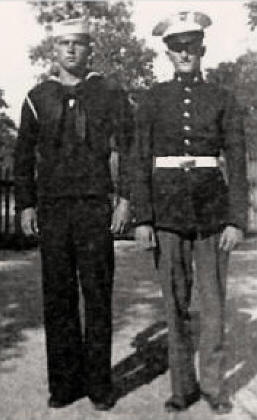
In the summer of 1946 a group of Niceville veterans began gathering in City Hall to form an American Legion Post. The plans came together and were completed on August 15, 1946. The Charter for American Legion, Oliver D. Nichelson Post 221 of Niceville was official, with 15 charter members. Joel C. Helms was the first Commander. A short time later, Cecil L. Anchors was the first elected Commander.
The land the Post was built upon was donated by a member of the Meigs family. Post members borrowed $5,000 from a man who ask for no collateral and built a 30-by-70 foot building on John Sims Parkway.
At that time, John Sims Parkway was a dirt road. They had numerous fish fries (probably mullet) and dance parties to pay off the loan. Since it was the largest building in Niceville, many others used it for meetings and parties. At that time there was no air conditioning and it got very hot inside, so they poured a concrete slab behind the building for outside gatherings and square dances.
The Post was named in honor of Corporal Oliver Daniel Nichelson, son of Thomas and Alvaretta Nichelson of Niceville. Oliver was Niceville's first causality of WWII. He had enlisted in the U.S. Marines in December 1939 in San Francisco and was serving in the Marine detachment aboard the USS Lexington (CV-2) in the Coral Sea.
In February and March 1942, Lexington raided Japanese positions in the southwestern Pacific, then returned to Pearl Harbor for a brief overhaul and removal of her eight-inch guns. In early May, Lexington returned to the South Pacific in time to join sister ship USS Yorktown (CV-5) in successfully countering the Japanese offensive in the Coral Sea.
On 7 and 8 May 1942 her planes helped sink the small Japanese aircraft carrier Shoho and participated in attacks on the large carriers Shokaku and Zuikaku.
In turn, however, she was the target of Japanese carrier planes and received two torpedo and three bomb hits. Though initial damage control efforts appeared to be successful, she was racked by gasoline explosions in the early afternoon of 8 May.
Aircraft from the morning's air strike began landing at 13:22 and all surviving aircraft had landed by 14:14.
Another serious explosion occurred at 14:42 that started severe fires in the hangar and blew the forward elevator 12 inches above the flight deck. Power to the forward half of the ship failed shortly afterward. Rear Admiral Frank Jack Fletcher sent three destroyers to assist, but another major explosion at 15:25 knocked out water pressure in the hangar and forced the evacuation of the forward machinery spaces.
The fire eventually forced the evacuation of all compartments below the waterline at 16:00 and Lexington eventually drifted to a halt.
Evacuation of the wounded began shortly afterward and Captain Frederick Sherman ordered "abandon ship" at 17:07. A series of large explosions began around 18:00 that blew the aft elevator apart and threw aircraft into the air. Sherman waited until 18:30 to ensure that all of his crewmen were off the ship before leaving himself. Some 216 crewmen were killed and 2,735 officers and men were rescued by the rest of the task force.
The destroyer USS Phelps was ordered to sink the ship and fired a total of five torpedoes between 19:15 and 19:52. Immediately after the last torpedo hit, Lexington capsized to port and sank; the first U.S. aircraft carrier to be lost in World War II.
Cpl Nichelson died of his wounds aboard the USS New Orleans May 8, 1942 and was buried at sea the next day. He was 22 years old. He was posthumously awarded the Purple Heart.
Parade in Niceville. Circa 1939

Oliver in his new Marine uniform with his twin brother Jack in his equally new Navy uniform. Circa 1939
